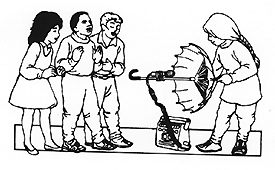AstroCappella: Cosmic Radio Show

The Communications Lab
An activity by Kara C. Granger
Activity Summary:
During this activity, students will build and test a type of communication system called a parabolic-dish receiver. This type of system is exactly like radio telescopes, which are discussed in our song. In particular, students will understand how signals are transmitted and captured with this system.
Objective:
Students will perform an outdoor experiment in which they will directly encounter technology that forms the backbone of many basic communication system components.
Materials for each group of students:
- light source such as sunlight or an incandescent light
- scissors
- meter stick
- portable tape recorder with detachable microphone
- batteries for tape recorder
- headphones for tape recorder
- umbrella with mylar or aluminum foil coating inside
- thermometer
(we recommend thermometers such as the temperature probe for CBL or an electronic thermometer. If neither of these devices is available, use an ordinary thermometer, but make note of the directions in step 3 of the procedure.)
Procedure:
1. Direct students to come together as a team of four to construct a parabolic-dish receiver.2. Students should open the umbrella, coat the inside of it with mylar or aluminum foil, and position it so that the mylar or aluminum foil coating inside is facing the light source.
3. Students should take the thermometer and move it up and down the umbrella pole, noting the temperature at each location. Tell students that what they are doing is searching for the focal point of the umbrella-- the point on the pole where the transmitted light focuses its greatest strength.
Make sure that the students either use the temperature probe from the CBL or an electronic thermometer. If neither of these devices is available, make sure that the students 'shake down' the thermometer after each reading on the umbrella pole.
4. Students should mark this point with a piece of tape. Why would this point be the hottest?
5. Students should next tape the microphone to the focal point on the pole of the umbrella. Make sure the microphone is in a position where the head is facing the inside of the umbrella, and plug the microphone and headphones into the tape recorder.
6. Now students should have 3 members stand shoulder to shoulder, while the 4th team member puts the headphones on and holds the parabolic microphone (umbrella with microphone) so that the inside of the umbrella faces the other 3 members. This student should hold the umbrella by its sides or by the knob at the top. Make sure nothing blocks the line of sight between the parabolic microphone and the other 3 team members.
7. Next, the student holding the parabolic microphone should push the record button on the tape recorder, and the group of three team members should begin singing their favorite AstroCappella song. Adjust the volume on the tape recorder so that the song is clear. The person holding the microphone should then slowly move directly backward and away from the singers until the song can no longer be heard through the headphones. Measure the maximum distance that the sound traveled and record this information.
8. Remove the microphone from the umbrella handle and hold it in your extended hand about the same distance from your body as it was when taped to the umbrella focal point. Make sure that the microphone is facing the singers. Repeat steps 6 and 7, using the hand-held microphone instead of the parabolic microphone.
Make sure NOT to record over the first song. Later, you might need both.
Extensions or Further Discussion:
1. Why was the song recorded with the parabolic microphone clearer?2. How did the sound get to the microphone?
3. Where have you seen parabolic microphones used before? (e.g., sporting events, outdoors for recording birds or other animals, etc.)
4. If a parabolic dish is a good device for receiving a sound signal, why would it also be a good device for transmitting a signal? (Think about the way in which the umbrella focused the sound signal.)
Reference:
The general idea for this lesson plan was adapted from a lesson located in the "JASON VII: Adapting to a Changing Sea" curriculum.
